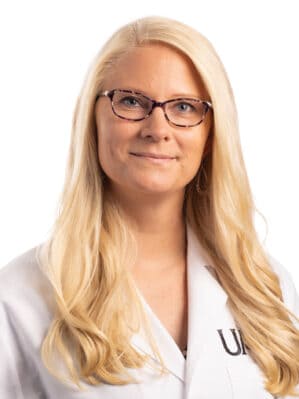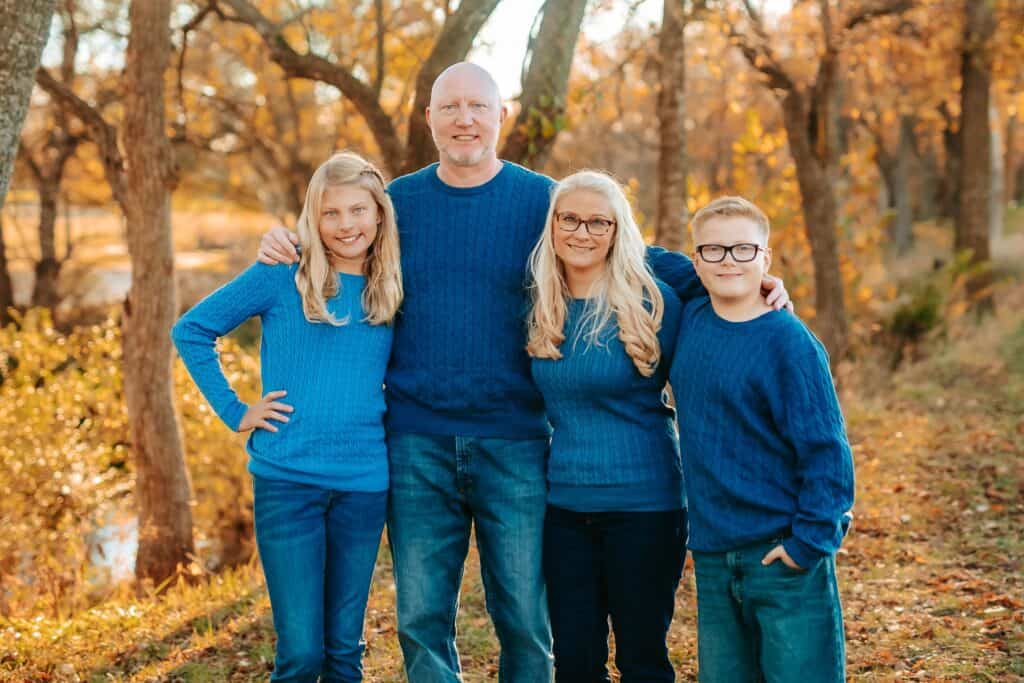This edition of Medicine & Meaning brings a very special Conversation piece by Hanna K. Jensen, M.D., Ph.D.

Dr. Jensen is an Assistant Professor in the Division of Trauma and Acute Care Surgery, in the Department of Surgery, based at the UAMS Northwest Regional Campus in Fayetteville. She is the course director for the Cardiovascular Module at the College of Medicine, and coordinates research in the departments of Surgery, Radiology, and the Northwest Regional Program. She earned her medical degree in 2007 and doctorate in 2008 from the University of Oulu in her native Finland. When approached by the Conversations Team for an interview regarding herself, Dr. Jensen prepared this piece, which we hope you will enjoy.
M.D. or not M.D. – That is the Question
“Is there a doctor on the plane?” The crackling intercom pulled me out from a fitful sleep somewhere above Bolivia around 2 a.m. It took a long time to get my bearings – I had traveled from Finland through Copenhagen and Atlanta to board a plane towards Buenos Aires for the World Society of Cardiothoracic Surgeons’ annual meeting. Back then, in 2009, I had recently graduated an eight-year program with my M.D./Ph.D. and was working towards my general surgical residency credits in a small district hospital in Northern Finland.
“If there is a doctor on the plane, please make your way towards the bathrooms in the back of the aircraft.” I kicked off my tangled blankets, wiped the drool off my cheek, and climbed over my fiancé to the aisle, gaining more purpose with each step as I strode towards the back of the plane. Most people were asleep, the lights were dim, and only the occasional movie-watcher turned their head toward me as I closed the length of the aircraft, shaking tiredness from my sleepy and jet-lagged brain, running through possible scenarios and trying to guess what was waiting for me by the bathrooms.
I felt pretty confident. I had been taking call in general practice since my fourth year of medical school (in Finland med school lasts for seven years but you are able to practice supervised after the fourth year), and I had been the first call for surgery for almost a year at that point in a remote hospital that served a sparsely inhabited but massive area. I had treated chest pain, infections, skiing accidents, allergic reactions, and the breadth and variety of issues encountered at ERs. I was used to limited resources and trouble-shooting until a patient could get to a more well-equipped healthcare unit. During my rotations, I slept with an on-call phone for obstetrics, and delivered my fair share of babies, so I felt decent about my chances of being able to at least somewhat manage what was needed at the back of the plane.
“How can I help?” I arrived at the cluster of flight attendants and crew members gathered over a young man lying down in front of the bathrooms. I was met with silence and disbelieving stares. “You’re a doctor?” one of the flight attendants questioned. I stand proudly at 5’2”, and I have no doubt that the 28 hours of travel under my belt did not render me the most credible-looking member of the physician community, so I was not entirely surprised by the question. “Yes, I am, I’m a surgical resident in Finland,” I replied, subconsciously trying to tighten my ponytail to look more respectable. “What’s the issue?” I asked.
The flight attendant stepped towards me, blocking my view of the patient and asked, “Do you have a copy of your license?” I was confused. I had never carried any type of documentation about my profession, and I thought it was a silly thing to ask when I was offering to help. “No, I don’t, I’m sorry,” I said. She continued to ask me whether I practiced in the United States, which I didn’t. She looked at me resignedly and said “I’m going to ask you to go sit back down, Miss.” I can’t lie, after earning my medical degree and my doctorate in cardiothoracic surgery, that “Miss” hurt much more than it probably should have. At this point, a middle-aged American man had arrived from the other side of the plane, and he had apparently convinced the cluster of existing helpers of his medical credentials as he bent over the young man. It looked like the patient was stirring after most likely a regular syncope, so I turned around and walked back to my seat. I probably imagined it, but I felt hot burning stares of other passengers on my back as I made my way back. I felt like a fake, and as a young professional so often riddled with impostor-syndrome, this was a hard one to swallow.
While this US-based airline was simply following their protocol, it was my first experience as “not-quite-a-doctor,” which became my permanent state as we immigrated to the US in 2014 through my husband’s employment. We landed on the shores of the home of the brave with a one-year-old and a three-year-old, during a time in my life where I survived on less sleep than I ever thought possible. I was coming off a two-year postdoc in the cardiac unit of a prestigious children’s hospital in London, UK, and while I dreamt of returning to clinic almost incessantly, I also occasionally, after sleepless nights, sprayed hairspray under my arms thinking it was deodorant. I vividly remember not too many months prior, meeting with the director of the European Tissue Bank and giving a very professional presentation about an EU-sponsored multi-center study, while to my horror realizing that Cheerios were falling out of one of my jacket sleeves every time I let that hand fall to my side. It’s a stage in life every mother of small children recognizes.

In the tumult of settling into a new country, parenting two small children, and learning a new job (a wonderful one as a clinical research associate in a large metropolitan hospital), the thought of having to study for Step exams, compile a compelling ERAS application, fly the country for interviews (if so lucky as to get any), and commit to a residency training – again – for five years in wherever I happened to match, was unfathomable. I have never been a lazy person, but parenthood had taught me more about my boundaries than anything else in my life combined. My priorities had shifted, and I knew that without a solid network of helpers (such as grandparents, aunts, and uncles), our family had its limits. So, I became one of the estimated 70,000 foreign-educated doctors in the United States who do not practice medicine.
Since then, life began to feel like a square peg and a round hole, especially as we relocated to a much smaller town in a rural state. What do you do with a medical degree when you don’t practice clinically? With every rejection from ill-fitting job searches, my self-respect crumbled a bit more. I had been so proud of my credentials up until this moment; I had worked my tail off for a decade to earn them. Now I was almost apologetic of them – they made me “too-highly qualified” or were simply not a good match for anything else but the one thing that I could not do.
I stopped telling people I had been trained as a surgeon. Just like being turned down from helping on that plane, admitting to my background without a job to go with it made me feel like a failure. I was less-than. It was easier to say “researcher” or “scientist” and hope for no follow-up questions. I was fortunate to be gainfully employed all this time, mostly due to my husband negotiating me in his job packages (his engineering credentials transferred over without issue). But I was always the body in the two-body-problem. I was forever the “spousal hire.” For a strong, stubborn, independent woman, this was slowly adding bricks to the backpack of shame I was carrying professionally. I wasn’t bitter, because I fully understood why the US system wanted all of their physicians trained here. I respected their requirements, and my only sorrow was that there was no clear off-ramp from clinical medicine. It was in a limbo existence that often had me questioning whether there’d ever be a space for me.
Like in so many stories of life, mine turned, thanks to a chance encounter, and an individual who saw something in me I had not even considered. I now work in clinical research in a unique position where I get to interface with med students, residents, fellows, faculty, allied health professionals, scientists, and more. Recently, as a complete surprise, a role that I had secretly coveted but never been brave enough to ask for was offered to me; I now teach medical students about the cardiovascular system. I am fulfilled, and I feel like I was hired for who I am and what I can do. It’s not clinical work, but there have been times, especially over the past pandemic years, when that hasn’t stung as much as it used to. I still feel less-than, and I don’t think that feeling will ever fully go away. But I do feel like I am making a difference, and for any doctor, that is a reward in itself. Whether I’d get out of my seat in an airplane if a doctor is called… I want to think that I would, because the oath I took still compels me to always help if I can, whether my previous training is officially recognized or not.
I still write the M.D. after my name, and I’ve started to share about my clinical background again. Our children say: “mom used to be a doctor, and now she’s a research doctor.” Life is a puzzle, and a job is a big piece, but it’s only one piece. There are tens of thousands of people in the country like me, and I know every one of them carries some pain, some shame, but also various perspectives of value. Many of them will accept jobs that are very distant to the calling they were hoping to answer, and evolve to see elements of medicine and healing in unexpected environments. I was supposed to become a pediatric cardiac surgeon. But like they say: sometimes you need to let go of the life you planned, to be able to live the life that was meant for you. I am finally making my peace with my unique M.D.
